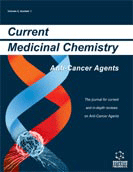Abstract
The present review focuses on the structural modifications responsible for the transformation of an antibacterial into an anticancer agent. Indeed, a distinctive feature of drugs based on the quinolone structure is their remarkable ability to target different type II topoisomerase enzymes. In particular, some congeners of this drug family display high activity not only against bacterial topoisomerases, but also against eukaryotic topoisomerases and are toxic to cultured mammalian cells and in vivo tumor models. Hence, these cytotoxic quinolones represent an exploitable source of new anticancer agents, which might also help addressing side-toxicity and resistance phenomena. Their ability to bind metal ion cofactors represents an additional means of modulating their pharmacological response(s). Moreover, quinolones link antibacterial and anticancer chemotherapy together and provide an opportunity to clarify drug mechanism across divergent species.
Keywords: quinolone family, antibacterial, anticancer agents, type II topoisomerase enzymes, topoisomerases, cytotoxic quinolones, anticancer chemotherapy
 8
8

















